Acer AL2216W: a worthwhile compromise?
by Jarred Walton on March 10, 2007 3:00 PM EST- Posted in
- Displays
Viewing Angles
We mentioned earlier that we would revisit some of the aspects of the other displays, and viewing angles are one of those areas that several readers wanted us to explore further. We used our camera to take shots from head-on as well as from the left and right sides at ~30° angles, showing how brightness and contrast ratios can drop dramatically in off-angle viewing. We also took pictures from above and below at ~30° angles. Here's the quick comparison of all the LCDs we have reviewed so far.
If it's not patently obvious from the above images (which we sorted in order of increasing quality), the viewing angle of the Acer's TN panel is much worse than any of the other tested displays. The Dell 3007WFP is in fourth place, which considering the use of an IPS panel was somewhat unexpected as IPS panels are known for providing a wide viewing angle. The sheer size of the panel may be partly to blame; getting accurate photos from the top and bottom angles was difficult, and subjectively we actually felt the 3007WFP was slightly better than the 2405FPW. The Dell 2405FPW places next, and considering that display is two years old it still makes a reasonable showing. The Gateway FPD2485W and Dell 2407WFP are basically tied for first, and while the placing was not a foregone conclusion their relative performance isn't at all surprising considering the two panels appear to be virtually identical.
We wouldn't be too concerned about viewing angles personally, as outside of the Acer display, all of the LCDs are generally acceptable for use within a 60° viewing arc, both horizontally and vertically. The Acer panel suffers mostly in the vertical viewing angle, so it can still be used within a 60° arc provided your eyes are in roughly the same vertical plane. Beyond a 30° angle, the IPS panel on the 3007WFP does seem to have a slight edge; however, we don't generally think most people use their computers staring at the screen from an oblique angle.
Anyone who is seriously concerned about accurate colors is going to want to view pretty much any display from a direct front angle, and that tends to be the most comfortable position as well. That's one of the reasons we don't really worry too much about viewing angles. However, some people might work in environments where off-angle viewing is more important, so it's not entirely meaningless.
Unfortunately, the manufacturer viewing angles tend to be exaggerated to the point of being useless, as the standard requirement is that the perceived image only needs to maintain a 10:1 contrast ratio. Even the extremely dark lower image on the Acer display above meets that requirement, but we can't imagine anyone would actually be able to use a display properly that way. When you have marketing material hyping 700:1 and even 1000:1 contrast ratios, it's ludicrous to even pretend that a 10:1 ratio is acceptable. 100:1 is good enough in a pinch, and maybe even a bit lower, but a 10:1 ratio is not at all practical.
We mentioned earlier that we would revisit some of the aspects of the other displays, and viewing angles are one of those areas that several readers wanted us to explore further. We used our camera to take shots from head-on as well as from the left and right sides at ~30° angles, showing how brightness and contrast ratios can drop dramatically in off-angle viewing. We also took pictures from above and below at ~30° angles. Here's the quick comparison of all the LCDs we have reviewed so far.
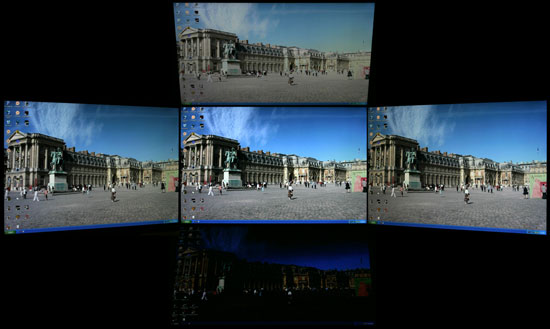 Acer AL2216W |
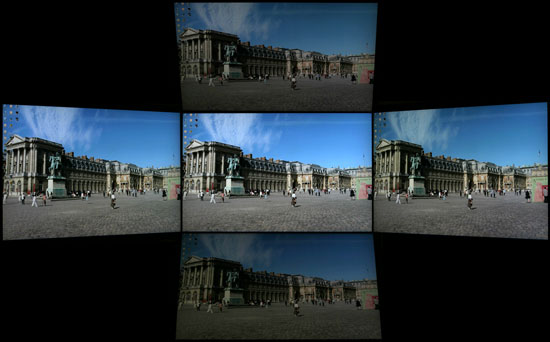 Dell 3007WFP |
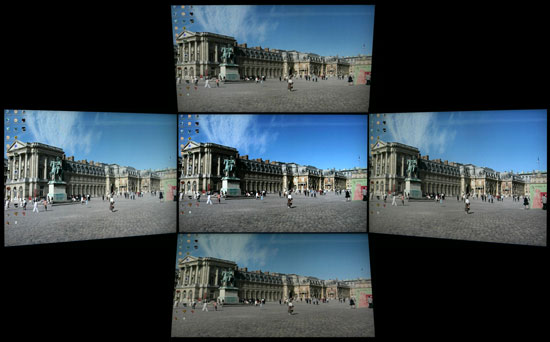 Dell 2405FPW |
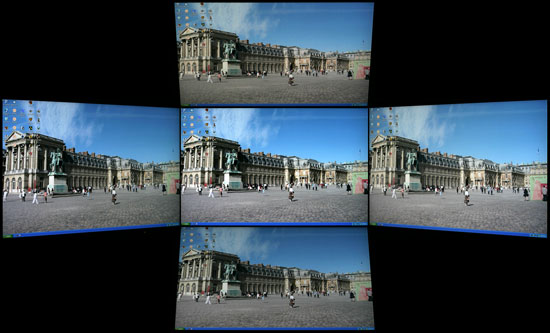 Dell 2407WFP |
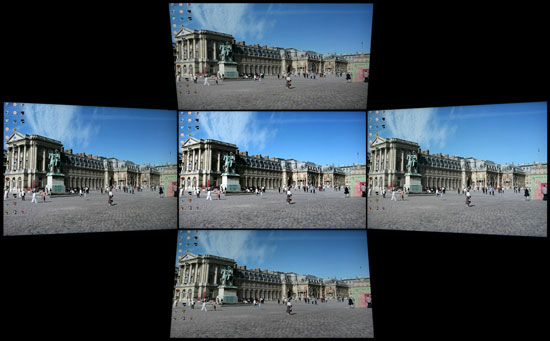 Gateway FPD2485W |
If it's not patently obvious from the above images (which we sorted in order of increasing quality), the viewing angle of the Acer's TN panel is much worse than any of the other tested displays. The Dell 3007WFP is in fourth place, which considering the use of an IPS panel was somewhat unexpected as IPS panels are known for providing a wide viewing angle. The sheer size of the panel may be partly to blame; getting accurate photos from the top and bottom angles was difficult, and subjectively we actually felt the 3007WFP was slightly better than the 2405FPW. The Dell 2405FPW places next, and considering that display is two years old it still makes a reasonable showing. The Gateway FPD2485W and Dell 2407WFP are basically tied for first, and while the placing was not a foregone conclusion their relative performance isn't at all surprising considering the two panels appear to be virtually identical.
We wouldn't be too concerned about viewing angles personally, as outside of the Acer display, all of the LCDs are generally acceptable for use within a 60° viewing arc, both horizontally and vertically. The Acer panel suffers mostly in the vertical viewing angle, so it can still be used within a 60° arc provided your eyes are in roughly the same vertical plane. Beyond a 30° angle, the IPS panel on the 3007WFP does seem to have a slight edge; however, we don't generally think most people use their computers staring at the screen from an oblique angle.
Anyone who is seriously concerned about accurate colors is going to want to view pretty much any display from a direct front angle, and that tends to be the most comfortable position as well. That's one of the reasons we don't really worry too much about viewing angles. However, some people might work in environments where off-angle viewing is more important, so it's not entirely meaningless.
Unfortunately, the manufacturer viewing angles tend to be exaggerated to the point of being useless, as the standard requirement is that the perceived image only needs to maintain a 10:1 contrast ratio. Even the extremely dark lower image on the Acer display above meets that requirement, but we can't imagine anyone would actually be able to use a display properly that way. When you have marketing material hyping 700:1 and even 1000:1 contrast ratios, it's ludicrous to even pretend that a 10:1 ratio is acceptable. 100:1 is good enough in a pinch, and maybe even a bit lower, but a 10:1 ratio is not at all practical.










32 Comments
View All Comments
JarredWalton - Monday, March 12, 2007 - link
Newegg lists a http://www.newegg.com/Product/ProductList.asp?Subm...">bunch of 22" LCDs, with the Acer AL2223Wd and Chimei 221D being the cheapest. Actually, I'm curious as to what the difference in panel is between the AL2216Wbd and the AL2223Wd, as the latter has a better stand IMO. Looks like it has a slightly higher contrast as well - possibly a better display coating? Anyway, you can see in that list that specs are almost all identical between the 22" LCDs, so price and features are going to be the big factors.tercathian - Sunday, March 11, 2007 - link
w/ Base, (WxHxD)=20.2"x16.0"x7.8"; w/o Base,=27.16"x17.70"2.93". That base must reeaally scrunch things together! Otherwise another great Anandtech review. Glad to see monitors getting coverage again for a change.Upon visual comparison of BesBi's display lcd's, I passed on the Acer 22" that had a white line running top to bottom and picked the LG 22". Noticably crisper than any other brand, with purported 3000:1 contrast, for not much more $$$.
JarredWalton - Sunday, March 11, 2007 - link
Oops... yea, wrong display on the w/o stand measurements! I updated the size figures, for those that are interested. I'll also see about getting that LG LCD for review - looks interesting, as they may actually use something other than a TN panel.semo - Sunday, March 11, 2007 - link
1st, the color gradient for the gateway display links to the dell 2405fpw's (page 6).how does the dell 2405fpw look with an average delta e of 10.41? do you look at it and say "hmmm... something's wrong" even if there is no other display to compare it with? just wondering if a home user can detect color inaccuracies and do something about it or you get what you get and hope for the best (i assume a "home user" does not have access calibration equipment).
for the last several years i've largely ignored anything that has happened in display technology (other than glance over price tags) so imagine my surprise when i decided to bring myself up to date and found the crt is virtually extinct. i bought my pc and tv 5 years ago and crt was everywhere. i always thought i wouldn't switch to the thin stuff for decades and that my next tv would be a cheap hd ready tube.
anyway, i was wondering when will we see picture quality as good as crt used to provide and is lcd or plasma going to bring it to us. some of the displays at consumer shows seem to deliver the goods but anything that isn't plasma or lcd at the moment is just vaporware.
JarredWalton - Sunday, March 11, 2007 - link
Thanks for the link correction; that's fixed now for the Gateway chart.I'm not sure if the colors on the 2405FPW are just getting worse due to age or if it's always been off that far. If it's sitting next to another display display, I can certainly see a difference and the 2405 tends to look a bit washed out/yellow. If it's sitting alone on a desk, it actually doesn't bother me much, and going through some basic color calibration charts (i.e. calibrate by eye without the colorimeter) you can improve the colors to the point where it's about the same as the other displays (around 6-8 average delta E).
CRTs are dead/dying I think in part because they can't really be any cheaper to produce anymore. Even with current LCD prices, I'd wager the markup on all LCDs continues to be pretty good, while CRTs probably don't get more than a 10-20% markup because the market won't bear it. Especially quality CRTs cost quite a bit more to manufacture, and the companies that used to make such displays (Sony, NEC, etc.) have abandoned the CRT market as far as I'm aware.
yyrkoon - Sunday, March 11, 2007 - link
I still think 22" WS monitors cost too much, you can get a decent 19" WS for $179, so why the $100 markup for 3" diagonal ? It certainly cant be assurance against dead / stuck pixels . . .This is another problem I have with paying so much , eTailers, and manufactuers saying "must have 8 dead pixels, or more to replace monitor for a new one". That would be like me saying, "hey man, most of my money is not counterfit, but some of it is, but you can not have your monitor back, becasue you dont have a high enough percentage of bad vs good currency". Would be nice if these 'people' would come around to reality, this is the main reason I personally go through convoltions, every time I plunk down a good bit of my hard earned cash for a LCD . . .
I've yet to get any dead / stuck pixels, but I figure, it is just a matter of time. Anyhow, would be nice, if 'we the people' could 'rectify' this.
JarredWalton - Sunday, March 11, 2007 - link
The eTailers are just trying to protect themselves, and there's a simple solution: if you can't live with a few dead pixels, shop somewhere else. Local stores usually cost more but have better return policies.As for the cost, I paid $1100 for a 2405FPW 18 months back, and $300 for a rather lousy 19" LCD about the same time. Needless to say, while $300 may still be more than some people are willing to pay, prices have become much more reasonable across the board. It wasn't that long ago that 19" LCDs were at the $300+ price point for entry level models, and still people were willing to buy them.
yyrkoon - Sunday, March 11, 2007 - link
I understand WHY eTailers do what they do, but my whole point is basically, why are these companies (OEMs) getting away with what is obviously 'bad business'. I suspect this has to do with some 'fair trade' garbage, something a long the lines of why 3rd world countries are allowed to import food products into countries, that would not normally allow this food in to begin with ( IE, the food does not meet the countries standards for health and wellfare ).As for the bad 19" for $300, well, I too also paid ~$300 for one of mine (ViewSonic VA1912wb) around 12-18 months ago, and could not possibly be more pleased with it. Well, ok, maybe if it were free . . . Now, could you imagine, if you just spent $650 on a 24" WS, and had noticable bad pixels ANYWHERE on the screen ? Me, I'd be very upset.
All I'm really saying, is that 'we' need to let the OEMs this is not acceptable, until then, they will get away with whatever we let them get away with.
mindless1 - Monday, March 12, 2007 - link
It's real simple, they either have to sell the panels with the bad pixels or discard them (throw away if bad enough or divert to lower grade sales which is also a loss).If they take back these panels then it will cost more per monitor. They're not "getting away" with anything, if you don't like it don't buy their product. That's the catch, they can stipulate any return policy they like and won't have to alter it if they don't preceive it hurting sales.
It doesn't really hurt sales much because there aren't that many monitors with that many bad pixels, apparently they already sort the panels well enough that the sort criteria is lower than the defective product return criteria.
They're only getting away with it if/when someone actually has that many dead pixels. Who do you know that does? Unfortunately a lot of businesses have policies that (if I knew about them), would make be pause before doing business. You end up playing odds, what is your time worth to find a better policy and what other compromises are made with the alternative product? I have one LCD of several that has one stuck pixel. I can accept that as much as I can accept a bug in some other piece of hardware, as most hardware isn't perfect, it's just a matter of whether you notice the flaw or not.
yyrkoon - Sunday, March 11, 2007 - link
All I'm really saying, is that 'we' need to let the OEMs _know_ this is not acceptable, until then, they will get away with whatever we let them get away with.Anyhow, IM sorry that my little rant here, kind of hijacked the idea of this discussion area :/ It just seems, that 'the business', is slowly, but surely moving to a 'screw the cutomer for what they're worth' type attitude, and of course, this . . . sucks.
The good news is: From all the reviews of read on acer monitors over the last few months, have been very favorable on their behalf, at least concerning dead/stuck pixels, other issues do seem to pleague random models however, such as LCD not comming up until windows is booting (need to change BIOS settings ? SoL buddy . . .), to others not working properly with dual monitors attached to a video card ( monitor not operating at 'optimal' resolution).
Some of these issues would not likely bother the average user, while it would effect those who do need to adjust BIOS settings (without hooking up another monitor), or run dual monitors, etc, etc.